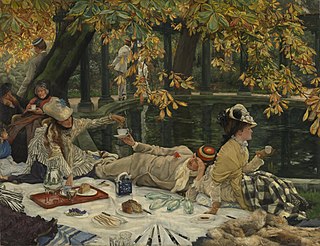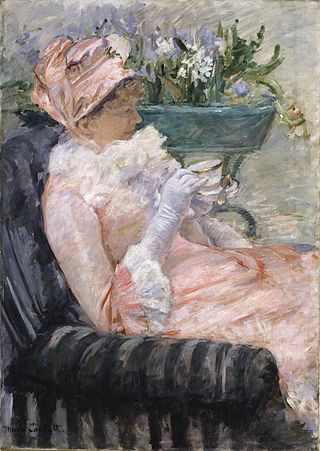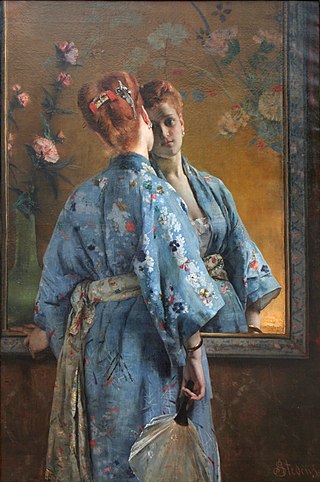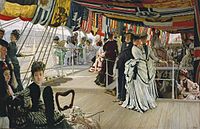
Berthe Marie Pauline Morisot was a French painter and a member of the circle of painters in Paris who became known as the Impressionists.

Mary Stevenson Cassatt was an American painter and printmaker. She was born in Allegheny, Pennsylvania, and lived much of her adult life in France, where she befriended Edgar Degas and exhibited with the Impressionists. Cassatt often created images of the social and private lives of women, with particular emphasis on the intimate bonds between mothers and children.
Events from the year 1877 in art.

Le Déjeuner sur l'herbe – originally titled Le Bain – is a large oil on canvas painting by Édouard Manet created in 1862 and 1863.

Jacques Joseph Tissot, better known as James Tissot, was a French painter, illustrator, and caricaturist. He was born to a drapery merchant and a milliner and decided to pursue a career in art at a young age, coming to incorporate elements of realism, early Impressionism, and academic art into his work. He is best known for a variety of genre paintings of contemporary European high society produced during the peak of his career, which focused on the people and women's fashion of the Belle Époque and Victorian England, but he would also explore many medieval, biblical, and Japoniste subjects throughout his life. His career included work as a caricaturist for Vanity Fair under the pseudonym of Coïdé.

Paul César Helleu was a French oil painter, pastel artist, drypoint etcher, and designer, best known for his numerous portraits of beautiful society women of the Belle Époque. He also conceived the ceiling mural of night sky constellations for Grand Central Terminal in New York City. He was also the father of Jean Helleu and the grandfather of Jacques Helleu, both artistic directors for Parfums Chanel.

The Shop Girl is a painting by James Tissot in the collection of the Art Gallery of Ontario. The painting depicts a young woman standing inside a shop selling ribbons and dresses. In one hand she holds a wrapped package of newly purchased items. With the other she holds open the door to the store for the viewer to depart. The shop is filled with piles of ribbons. Outside, a busy Parisian street scene is visible through the shop windows. A well dressed man stares in through the window and is greeted by the other girl in the shop.
The Cosmopolitan Club in London, England, was a club which existed from 1852 to 1902. It met in rooms at 30 Charles Street, off Berkeley Square, which had previously been the studio of George Frederic Watts and then of Henry Wyndham Phillips.

Plum Brandy, also known as The Plum, is an oil painting by Édouard Manet. It is undated but thought to have been painted about 1877. The painting measures 73.6 centimetres (29.0 in) by 50.2 centimetres (19.8 in). It depicts a woman seated alone at a table in a cafe, in a lethargic pose similar to that of the woman in Degas' L'Absinthe. The woman may be a prostitute, but unlike the subject of Degas' work she appears more dreamy than depressed. She holds an unlit cigarette and her plum soaked in brandy appears untouched.

Springtime or The Reader is an 1872 painting by the French Impressionist painter Claude Monet. It depicts his first wife, Camille Doncieux, seated reading beneath a canopy of lilacs. The painting is presently held by the Walters Art Museum.

Holyday, later also known as The Picnic, is an oil painting by French painter James Tissot (1836–1902), painted in 1876. Tissot moved to England in the year 1871, when he was thirty five years old and settled there. Before moving to London, Tissot was a successful painter of Paris society.

The North-West Passage is an 1874 painting by John Everett Millais. It depicts an elderly sailor sitting at a desk, with his daughter seated in a stool beside him. He stares out at the viewer, while she reads from a log-book. On the desk is a large chart depicting complex passageways between incompletely charted arctic islands.

Preparing for a Fancy Dress Ball, also known as The Misses Williams-Wynn, is a 173 by 150 cm oil on canvas by English artist William Etty, first exhibited in 1835 and currently in the York Art Gallery. Although Etty was then known almost exclusively for history paintings featuring nude figures, he was commissioned in 1833 by Welsh Conservative politician Charles Watkin Williams-Wynn to paint a portrait of two of his daughters. Preparing for a Fancy Dress Ball shows Williams-Wynn's daughters, Charlotte and Mary, in lavish Italian-style costume: Charlotte, the eldest, is shown standing, helping the seated Mary decorate her hair with a ribbon and a rose. Etty put a good deal of effort into the piece and took much longer than usual to finish it.

Summer's Day is an oil-on-canvas painting by the French Impressionist painter Berthe Morisot, created in 1879. The painting depicts two women seated in a row boat, and was painted in the Bois de Boulogne. It is held at the National Gallery, in London.

The American artist Mary Cassatt painted The Cup of Tea in Paris ca. 1879–1881. The painting depicts Mary's sister Lydia Cassatt in a typical, upper class-Parisian ritual of afternoon tea. Scholars have observed that Cassatt's choice to employ vivid colors, loose brushstrokes, and unique perspective to portray the scene makes it a quintessentially Impressionist painting.

Portsmouth Dockyard is an 1877 oil painting by French artist James Tissot. It is a reworking of his 1876 painting On The Thames, which also depicts a man and two women in a boat. It measures 15.0 by 21.5 inches.

Famille d'acrobates avec singe is a 1905 painting by Pablo Picasso. It depicts a family of travelling circus performers during an intimate moment. The work was produced on cardboard using mixed media: gouache, watercolour, pastel and Indian ink. It is held by the Gothenburg Museum of Art in Gothenburg, Sweden. The work was painted at a key phase in Picasso's life, as he made the transition from an impoverished bohemian at the start of 1905 to a successful artist by the end of 1906.

La Japonaise is an 1876 oil painting by the French Impressionist painter Claude Monet. Painted on a 231.8 cm × 142.3 cm canvas, the full-length portrait depicts a European woman in a red uchikake kimono standing in front of a wall decorated by Japanese fans. Monet's first wife Camille Doncieux modeled for the painting.

La parisienne japonaise is an oil on canvas painting by Belgian painter Alfred Stevens. It depicts a young woman in a blue kimono standing in front of a mirror. The painting testifies to Stevens' involvement with Japonisme. Stevens was one of the earliest collectors of Japanese art in Paris.

Madame Georges Charpentier and Her Children is an 1878 oil on canvas painting by Pierre-Auguste Renoir. It depicts Marguerite Charpentier, a French salonist, art collector, and advocate of the Impressionists, and her children Georgette and Paul. The painting is held by the Metropolitan Museum of Art.
























